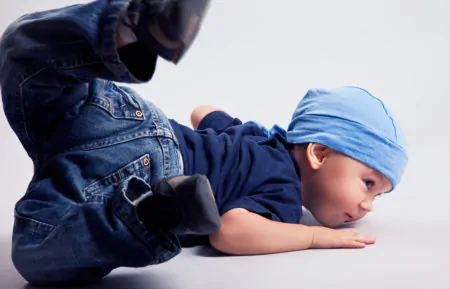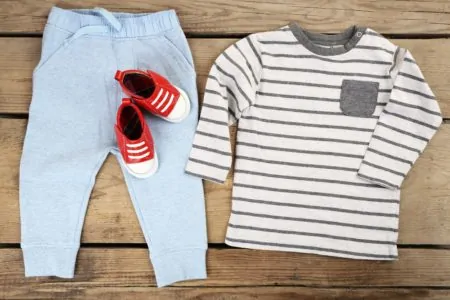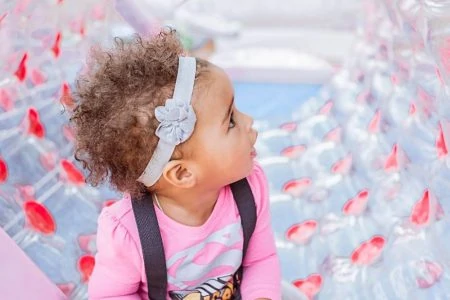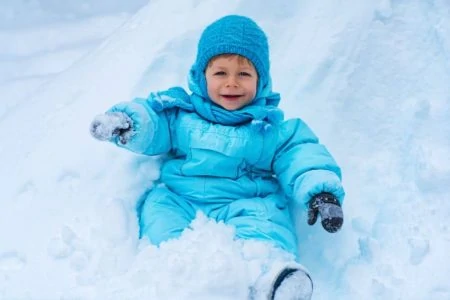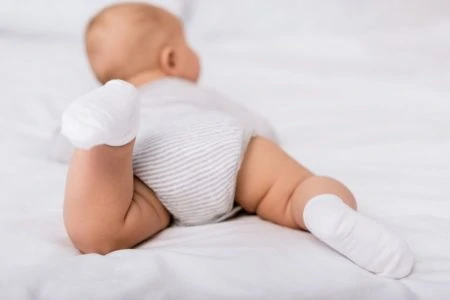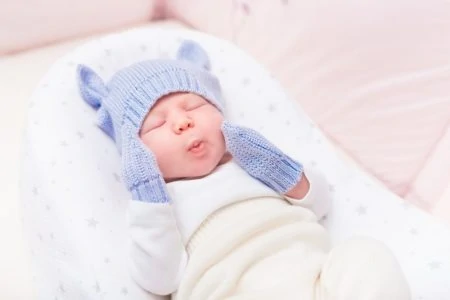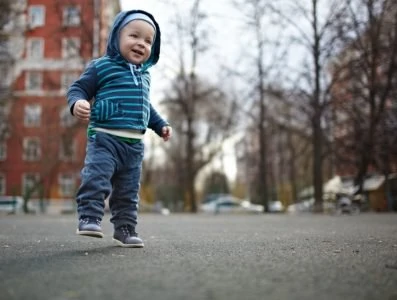Fit matters. Pants that are too tight restrict play, while loose ones become a tripping hazard.
This guide breaks down kids’ pants size charts by age and gender so you can shop with confidence. We will help you skip the returns line and find the perfect pair the first time.
Key Takeaways
- Baby sizing depends on weight and length: Months are just a suggestion; always measure height and weight for the best fit.
- Toddler vs. Kids: Toddler sizes (2T, 5T) have room for diapers, while kid sizes (4, 18) are cut for potty-trained children.
- Measure often: Track your child’s height, waist, and inseam before every shopping trip, as growth spurts happen overnight.
- Brand variations exist: Always check the specific manufacturer’s chart, as a size 6 in one brand might be a size 7 in another.
Baby Pants Size Chart (Boys and Girls)
Baby clothing sizes rely heavily on height and weight rather than just age. Use this chart as a starting point, but remember that cloth diapers may require sizing up for extra room.
| Size | Age | Height | Weight | Waist |
| Preemie | Up to 7 pounds | Up to 20.5 inches | Up to 7 pounds | 16.125 inches |
| 0 to 3 M | 0 to 3 months | 20.5 to 24 inches | 7 to 14 pounds | 16.125 to 17.375 inches |
| 3 to 6 M | 3 to 6 months | 24 to 27 inches | 14 to 18 pounds | 17.375 to 18.5 inches |
| 6 to 9 M | 6 to 9 months | 27 to 29 inches | 18 to 22 pounds | 18.5 to 19 inches |
| 9 to 12 M | 9 to 12 months | 29 to 30.5 inches | 22 to 26 pounds | 19 to 19.5 inches |
| 12 to 18 M | 12 to 18 months | 30.5 to 31 inches | 26 to 28 pounds | 19.5 to 20.25 inches |
| 18 to 24 M | 18 to 24 months | 32 to 33.5 inches | 28 to 30 pounds | 20.25 to 20.5 inches. |
Toddler Pants Size Chart (Boys and Girls)
Toddler sizes introduce the “T” label and usually account for diaper bulk in the seat. Measuring the inseam becomes critical at this stage to avoid tripping over long pant legs.
| Size | Age | Height | Weight | Hips | Waist | Inseam |
| 2T | 2 years | 33.5 to 35 inches | 30 to 32 pounds | 20.5 to 21 inches | 20.5 to 21 inches | 14 to 14.75 inches |
| 3T | 3 years | 35 to 38 inches | 32 to 35 pounds | 21 to 22 inches | 21 to 21.5 inches | 14.75 to 15.5 inches |
| 4T | 4 years | 38 to 41 inches | 35 to 39 pounds | 22 to 23 inches | 21.5 to 22 inches | 15.5 to 17 inches |
| 5T | 5 years | 41 to 44 inches | 39 to 45 pounds | 23 to 24 inches | 22 to 22.5 inches | 17 to 18.75 inches |
Girls’ Pants Size Chart (5 to 13 Years)
Once girls transition out of toddler sizes, brands switch to numeric sizes (4, 5, 6) or alpha sizing (XS, S, M). Sizing for girls often accounts for height and hip width more than waist size.
| Size | Age | Height | Weight | Hips | Waist | Inseam |
| 6 / S | 5 to 6 years | 44 to 46.5 inches | 45 to 50 pounds | 24 to 25 inches | 22.5 to 23 inches | 18.75 to 20.25 inches |
| 7 / M | 6 to 7 years | 46.5 to 50.5 inches | 50 to 57 pounds | 25 to 27.5 inches | 23 to 23.5 inches | 20.5 to 23 inches |
| 8 / M | 7 to 8 years | 50.5 to 52.5 inches | 57 to 65 pounds | 27.5 to 28.5 inches | 23.5 to 24.25 inches | 23 to 24.25 inches |
| 10 / L | 8 to 9 years | 52.5 to 55 inches | 65 to 75 pounds | 28.5 to 30 inches | 24.25 to 25 inches | 24.25 to 26 inches |
| 12 / L | 9 to 10 years | 55 to 58 inches | 75 to 86 pounds | 30 to 32 inches | 25 to 26 inches | 26 to 27.5 inches |
| 14 / XL | 10 to 11 years | 58 to 61 inches | 86 to 100 pounds | 32 to 34 inches | 26 to 28 inches | 27.5 to 29 inches |
| 16 / XXL | 11 to 12 years | 61 to 62.5 inches | 100 to 108 pounds | 34 to 36 inches | 28 to 30 inches | 29 to 29.5 inches |
| 18 / XXXL | 12 to 13 years | 62.5 to 64 inches | 108 to 115 pounds | 36 to 38 inches | 30 to 32 inches | 29.5 to 30 inches |
Boys’ Pants Size Chart (5 to 13 Years)
Boys’ sizes generally offer a bit more room in the rise (the distance from the crotch seam to the waistband). If your boy is active, look for reinforced knees and adjustable waistbands.
| Size | Age | Height | Weight | Hips | Waist | Inseam |
| 6 / S | 5 to 6 years | 44 to 46.5 inches | 45 to 50 pounds | 24 to 25 inches | 22.5 to 23 inches | 18.75 to 20.25 inches |
| 7 / M | 6 to 7 years | 46.5 to 49.5 inches | 50 to 58 pounds | 25 to 26.5 inches | 23 to 23.5 inches | 20.25 to 23.25 inches |
| 8 / M | 7 to 8 years | 49.5 to 52 inches | 58 to 68 pounds | 26.5 to 27.75 inches | 23.5 to 24.5 inches | 23.25 to 24.25 inches |
| 10 / L | 8 to 9 years | 52 to 55.5 inches | 68 to 87 pounds | 27.75 to 29 inches | 24.5 to 25.5 inches | 24.25 to 25.5 inches |
| 12 / XL | 9 to 10 years | 55.5 to 58.5 inches | 87 to 100 pounds | 29 to 30.5 inches | 25.5 to 26.5 inches | 25.5 to 27.25 inches |
| 14 / XL | 10 to 11 years | 58.5 to 61.5 inches | 100 to 110 pounds | 30.5 to 32 inches | 26.5 to 28 inches | 27.25 to 29.75 inches |
| 16 / XXL | 11 to 12 years | 61.5 to 64 inches | 110 to 120 pounds | 32 to 33.5 inches | 28 to 29.5 inches | 29.75 to 31 inches |
| 18 / XXXL | 12 to 13 years | 64 to 65.5 inches | 120 to 125 pounds | 33.5 to 35 inches | 29.5 to 31 inches | 31 to 31.5 inches |
Regular vs. Slim vs. Husky/Plus Sizing
Standard charts don’t fit every child. Many retailers now offer specific fits to accommodate different body types.
- Slim: Designed for children with smaller frames. The length remains the same as regular sizes, but the waist and leg openings are narrower to prevent bagging.
- Husky (Boys) / Plus (Girls): These sizes provide a roomier fit in the waist, hips, and thighs. They are perfect for kids who find regular buttons or zippers too restrictive.
- Adjustable Waists: Regardless of the size label, look for pants with internal adjustable elastic tabs. These are a lifesaver for customizing the fit.
How to Measure a Kid’s Pant Size
Guessing based on age is a recipe for returns. For accuracy, measure your child while they are wearing lightweight undergarments or tight leggings.
Use a soft cloth measuring tape and follow these steps:
- Hips: Wrap the tape around the fullest part of the seat. Keep the tape parallel to the floor.
- Waist: Measure around the natural waistline (the narrowest part), usually near the belly button. Don’t pull it too tight.
- Inseam: This determines the length. Measure from the top of the inner thigh (crotch seam) down to the bottom of the ankle.
- Height: Have your child stand straight against a wall without shoes. Measure from the top of their head to the floor.
Compare these numbers against the specific clothing brand’s size chart before buying.
Pants Fitting Tip
Tips for Buying Pants/Bottoms
Buying clothes for kids changes as they grow. Here is how to handle each stage like a pro.
Tips for Babies
Newborns grow rapidly, often outgrowing a size in just a few weeks (1).
- Size up: It is better to have pants that are slightly loose than too tight. Roll up cuffs if needed; they will grow into them quickly.
- Prioritize diapers: Cloth diapers add significant bulk. Look for “harem” style pants or brands known for a wider cut in the seat.
- Skip the buttons: Snaps, zippers, and buttons are a nightmare during 3 a.m. changes. Stick to elastic waistbands.
- Fabric matters: Soft cotton or bamboo blends prevent irritation on sensitive baby skin.
Tips for Toddlers
Toddlers are active explorers, so their clothes need to be durable and functional.
- Self-dressing friendly: Elastic waistbands empower toddlers to pull their own pants up and down, which is crucial for independence.
- Potty training checks: If you are potty training, ensure the pants are easy to remove in a hurry. Avoid overalls or complicated belts.
- Durability: Look for reinforced knees. Toddlers spend a lot of time crawling and playing on the floor.
- Try them on: If possible, bring your toddler to the store. Make it a game to see which pants make them run the fastest.
Tips for Older Kids
As kids grow, their opinions on style and comfort become more defined.
- Involve them: Let your child have a say in the style. If they hate the texture of denim, forcing them to wear jeans isn’t worth the battle.
- Anticipate growth: Girls often hit growth spurts until age 14, and boys until 16 (2). If they are between sizes, go up a size and use a belt.
- Use a reference pair: If shopping alone, bring a pair of their current pants that fit well to compare against new ones in the store.
- Save measurements: Keep a note on your phone with their current stats. Update it every few months.
- Stick to favorites: Once you find a brand that fits your child’s body type perfectly, stick with it to save time.
International Conversion Chart
Shopping online opens up a world of brands, but sizes vary globally. Use this table to convert U.S. sizes to U.K., Australian, and European standards.
| U.S. | U.K. | Australia | Europe |
| 2 | 2 to 3 | 3 | 92 to 98 cm |
| 3 | 3 to 4 | 4 | 98 to 104 cm |
| 4 | 4 to 5 | 5 | 104 to 110 cm |
| 5 | 5 to 6 | 6 | 110 to 116 cm |
| 6 | 6 to 7 | 7 | 116 to 122 cm |
| 7 | 7 to 8 | 8 | 122 to 128 cm |
| 8 | 8 to 9 | 9 | 128 to 134 cm |
| 10 | 10 to 11 | 11 | 134 to 140 cm |
| 12 | 12 to 13 | 13 | 140 to 146 cm |
| 14 | 14 to 15 | 15 | 146 to 152 cm |
What Age Is Juniors Clothing For?
Juniors clothing is a category for teenage girls who have outgrown the “Girls” department but aren’t quite ready for “Women’s” sizes. Junior sizes are odd numbers (1, 3, 5, etc.), whereas Girls’ sizes are even numbers (12, 14, 16) and Women’s sizes are even (2, 4, 6).
A girl usually transitions to Juniors when she develops more curves in the hips and bust.
| Size | Height | Weight | Hips | Waist | Inseam |
| Junior 3 to 5 | 65 inches | Up to 110 pounds | 34 inches | 27 inches | 29 inches |
| Junior 7 to 9 | 67 inches | Up to 120 pounds | 36 inches | 27.5 inches | 30 inches |
| Junior 11 to 13 | 68 inches | Up to 135 pounds | 38 inches | 28 inches | 31 inches |
Kids Pants Size FAQs
In Conclusion
Finding the right pants size doesn’t have to end in tears. By keeping accurate measurements of your child’s height, waist, and inseam, you can ignore the confusing age labels and focus on the fit.Remember that brands vary, and kids grow fast. Keep this guide handy, measure often, and when in doubt, always size up for comfort.
